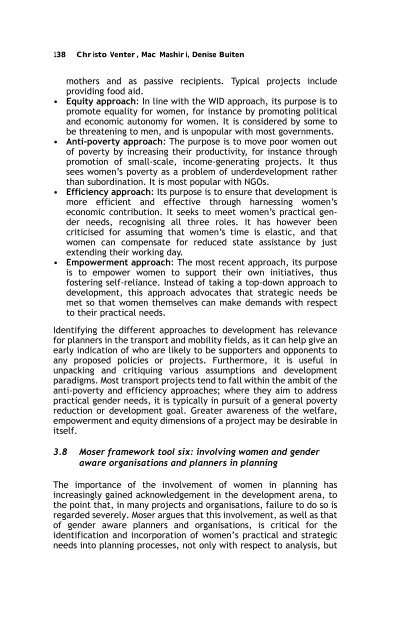Sex, Gender, Becoming - PULP
Sex, Gender, Becoming - PULP
Sex, Gender, Becoming - PULP
You also want an ePaper? Increase the reach of your titles
YUMPU automatically turns print PDFs into web optimized ePapers that Google loves.
138 Christo Venter, Mac Mashiri, Denise Buiten<br />
mothers and as passive recipients. Typical projects include<br />
providing food aid.<br />
• Equity approach: In line with the WID approach, its purpose is to<br />
promote equality for women, for instance by promoting political<br />
and economic autonomy for women. It is considered by some to<br />
be threatening to men, and is unpopular with most governments.<br />
• Anti-poverty approach: The purpose is to move poor women out<br />
of poverty by increasing their productivity, for instance through<br />
promotion of small-scale, income-generating projects. It thus<br />
sees women’s poverty as a problem of underdevelopment rather<br />
than subordination. It is most popular with NGOs.<br />
• Efficiency approach: Its purpose is to ensure that development is<br />
more efficient and effective through harnessing women’s<br />
economic contribution. It seeks to meet women’s practical gender<br />
needs, recognising all three roles. It has however been<br />
criticised for assuming that women’s time is elastic, and that<br />
women can compensate for reduced state assistance by just<br />
extending their working day.<br />
• Empowerment approach: The most recent approach, its purpose<br />
is to empower women to support their own initiatives, thus<br />
fostering self-reliance. Instead of taking a top-down approach to<br />
development, this approach advocates that strategic needs be<br />
met so that women themselves can make demands with respect<br />
to their practical needs.<br />
Identifying the different approaches to development has relevance<br />
for planners in the transport and mobility fields, as it can help give an<br />
early indication of who are likely to be supporters and opponents to<br />
any proposed policies or projects. Furthermore, it is useful in<br />
unpacking and critiquing various assumptions and development<br />
paradigms. Most transport projects tend to fall within the ambit of the<br />
anti-poverty and efficiency approaches; where they aim to address<br />
practical gender needs, it is typically in pursuit of a general poverty<br />
reduction or development goal. Greater awareness of the welfare,<br />
empowerment and equity dimensions of a project may be desirable in<br />
itself.<br />
3.8 Moser framework tool six: involving women and gender<br />
aware organisations and planners in planning<br />
The importance of the involvement of women in planning has<br />
increasingly gained acknowledgement in the development arena, to<br />
the point that, in many projects and organisations, failure to do so is<br />
regarded severely. Moser argues that this involvement, as well as that<br />
of gender aware planners and organisations, is critical for the<br />
identification and incorporation of women’s practical and strategic<br />
needs into planning processes, not only with respect to analysis, but
















